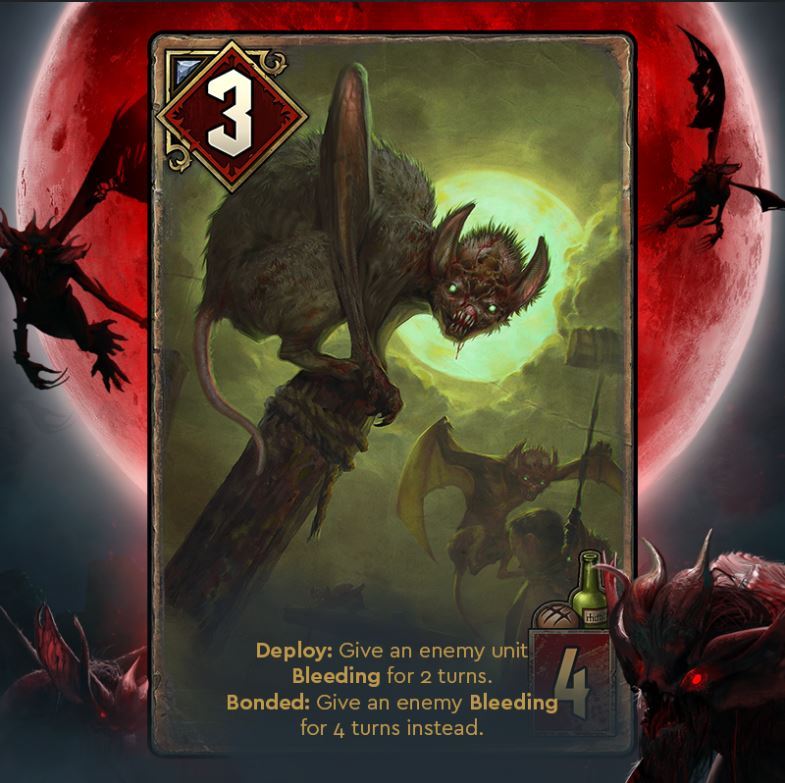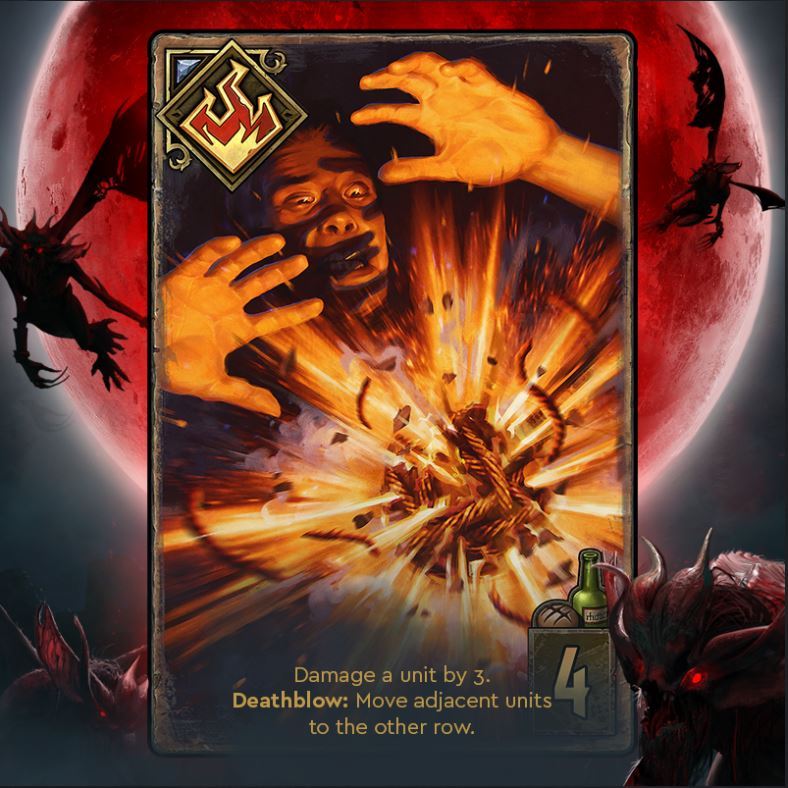

Rapid Reaction: Crimson Curse Reveal and First Five Cards
On the 4th March 2019, Gwent announced its first official expansion, "Crimson Curse", available for release on the 28th March 2019, according to the card image gallery. You can watch the first teaser for Crimson Curse, themed around the higher vampire Detlaff van der Eretein and a spell he cast, below.
CD Projekt Red’s marketing copy states that Crimson Curse will add "over 100 new cards" to the game. Doing the calculations (14 new cards for each of the 5 factions, plus 31 neutral cards) yields a total of ... 101 new cards. Gaunter O'Dimm would be proud.
While Crimson Curse is not the first addition of so many new cards to the existing game, as December 2017's ill-fated Midwinter Update was also over 100 cards large, it is the first to have a specific theme and it is confirmation, as if any were still needed, that this version of Gwent will be its overall form going forward.
In addition to announcing Crimson Curse, CD Projekt Red also revealed the first five cards of the expansion. All showcase new keywords to be introduced with Crimson Curse. Perhaps most tellingly, aside from Windhalm of Attre, all are low-provision bronze cards. It's a clever way of stirring hype: if these are the bronzes, what will the gold cards do?

Northern Realms card Windhalm of Attre marks the introduction of the Shield keyword...or, more accurately, a reintroduction. As McBeard pointed out on the Commander's Horn podcast, Shield appeared on a rather infamous card, Quen Sign, which was removed from Gwent with the Midwinter Update in December 2017.
Quen Sign presented major technical issues in the old Gwent, but those appear to have been solved. Whether Shield will be a Northern Realms-only mechanic or will be more widespread is an open question; reading the Crimson Curse announcement closely, the text under Windhalm of Attre makes no mention of Northern Realms, unlike for Dryad Ranger, Plumard, and Disgraced Brawler.
As for Windhalm of Attre itself, the play patterns appear to be fairly simple. It comes down at 2 power. Assuming the player does nothing to deal damage to Windhalm, it keeps its Shield and goes up to 4 power at the player's end. If the opponent does not damage Windhalm – or even if the opponent does, but the player replaces its Shield – it goes up to 6 power at the end of the player's next turn, and so on.
The strength of Windhalm of Attre depends heavily on how many damaging effects there are in the metagame. With little damage, Windhalm can run rampant, or at least run interference for more important engine cards. If small-damage abilities are everywhere, Windhalm is more likely to be an underwhelming four points of power for seven provisions. Only time will tell.

Dryad Ranger presents decent value even without its keywords: It is effectively a Wolf Pack without the reach requirement and costing one more provision. The keywords, however, make Dryad Ranger more interesting.
First is Harmony. Harmony buffs a card it is on "by one the first time a new Scoia'tael race joins the battlefield." This vague wording does not have all the details necessary to judge the ability. Does it apply within rounds only? If Dryad Ranger enters the board while an Elf is on it, the Elf goes to the graveyard, and the player plays another Elf, does Harmony proc? We simply do not have enough information yet.
On the other hand, Poison seems relatively straightforward. The first instance of Poison has no major effect, maybe adding a status to the targeted card; the second destroys the affected unit. Without knowing the broader context of Poison cards in the set, it is difficult to assess Poison's worth. That being said, the mechanic is all-or-nothing, inherently polarizing. Will it be too weak for competitive play, or will it be too strong and need nerfing? For the initial release, at least, I find a path between the extremes unlikely.

Monsters card Plumard gives me pause, because it suggests that its two keywords, Bleeding and Bonded, do not mean what most readers think they mean.
Before the keywords, Plumard is a three-power unit for four provisions. On deployment, it gives an enemy unit Bleeding for two turns. The teaser text reads, "Why destroy your enemies, when you can slowly Bleed them over time, causing them to lose power every turn." [sic]
Now, if we take this statement at face value, so long as the opponent has a targetable unit for the Deploy ability, that makes for an effective five power for four provisions, an excellent rate for a four-provisions bronze card.
Add in that second ability, Bonded, and an enemy can get Bleeding for four turns instead. Depending on the conditions for Bonded/Bonding (and the teaser text has a generic "Some monsters coordinate together" rather than a detailed explanation), Plumard ends up being either strong or amazing.
What, then, is the catch? Is Bleeding easy to stop? Is Bonding hard to pull off? Is the community misunderstanding Plumard? Or is it simply an overpowered card that does not belong at its highly efficient numbers?

At seven power for five provisions, you just know there has to be a catch to this Skellige card. Disgraced Brawler's catch lies in its Berserk ability, which destroys the unit "on reaching half health," per the teaser text. (Though the unit locks itself if the opponent has three damaged units, thanks to Bloodthirst 3. This is mighty complicated for a bronze card!)
Berserk seems fairly straightforward. On Disgraced Brawler the Berserk ability is negative, but positive abilities are easy to imagine. The biggest unanswered question: up or down? As in, does Disgraced Brawler go Berserk at four power (half of seven, rounded up) or three power (half of seven, rounded down)? The latter seems far more playable than the former, though Ulfhedinn suggests Disgraced Brawler will round up (thanks to Molegion for pointing this out to me).

Aside from the novelty and potential usefulness of moving units to the other row, Samum is most notable for the Deathblow keyword. The keyword itself is new, though what it describes is not. Arachas Venom, Kaedweni Revenant, and Rivian Pikeman all have Deathblow abilities, simply written out as "If it was destroyed..." for now. It would not surprise me to see all three of those cards reworded with Crimson Curse (as in fact they were, briefly, after the Seasonal Tree update last week).
Samum itself could lead to some interesting interactions with the game rules, particularly when spying units are involved (I think I know how Sabrina Glevissig and Samum interact, but I'm not confident enough to type it out). For now, we know that Deathblow is a new keyword for an old ability, and the short form of the keyword might open up new cards that would have been too wordy to put in Gwent under the old ways. I look forward to seeing what CD Projekt Red comes out with next!

Author
lordgort
"Professional hobbyist" lordgort makes his money helping others enjoy their leisure, whether as an auction catalog writer, copy editor for a Magic: The Gathering strategy site, or game show contestant (lifetime winnings: $5000). A Magic columnist for seven years, in 2018 he turned to Gwent, swiftly reaching the Pro ranks. Off the clock, he relaxes by writing and editing Gwent articles and contributing to Aretuza Academy. A longtime game show fanatic, he appeared on Who Wants To Be A Millionaire in 2018.




